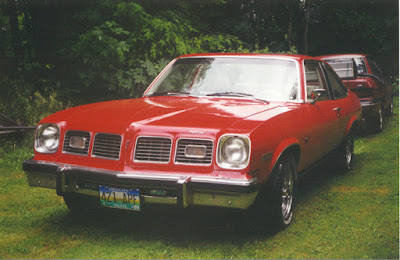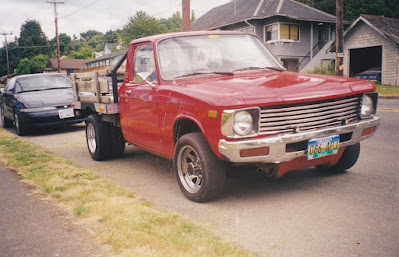Monday, January 14, 2019
1940 Packard One-Ten Club Coupe
Responding to the Great Depression, luxury automaker Packard introduced a line of cars powered by six-cylinder engines in 1937, alongside its eight-cylinder powered standard One-Twenty line. Initially called simply the Packard Six, the smaller Packard line was renamed Packard One-Ten in 1940. The Packard One-Ten series had a 122-inch wheelbase, as opposed to the Packard One-Twenty line's 127-inch wheelbase, and was powered by a 245-cubic-inch six-cylinder version of Packard's L-head in-line engine that was rated at 100-horsepower, not much less than the One-Twenty's 120-horsepower 282-cubic-inch eight-cylinder engine. Packard built 62,300 One-Tens and 28,138 One-Twenties for 1940. The One-Ten line was expanded in 1941, but in 1942 the Packard One-Ten went back to being the Packard Six before World War II halted civilian Packard production. This 1940 Packard One-Ten Club Coupe was photographed in the Days in the Park parade in Rainier, Oregon, on July 8, 2000.
Labels:
1940,
Packard,
Rainier 2000
1975 Pontiac Ventura
Pontiac first introduced the Ventura name in 1960 as a higher-priced full-size model, and throughout the 1960s it alternated between being a model and being a trim level for the Pontiac Catalina. In 1971, Pontiac applied the Ventura name to its new rebadged version of the compact Chevrolet Nova. The Nova and its copies (the Pontiac Ventura, the Oldsmobile Omega, and the Buick Skylark & Apollo) were restyled for 1975, as illustrated by this example.
The Pontiac Ventura was marketed as a more luxurious sports car than the Chevrolet Nova. (Note that this example has an aftermarket steering wheel, but the rest of the interior is largely stock.)
The Pontiac Ventura was offered as a two-door coupe, a two-door hatchback, or a 4-door sedan. This is the hatchback version. By 1975, the Ventura was not available with a Pontiac engine, instead being offered with a variety of Chevrolet and Buick engines, with the Buick 350-cubic-inch V8 being the most powerful option.
The Ventura name would not last much longer. In the middle of 1977, Pontiac introduced another version of the Nova, the more luxurious Phoenix, which replaced the Ventura entirely for 1978.
Chevrolet LUV
The Chevrolet LUV pickup was a rebranded Isuzu that was introduced in America in 1972 to compete with the compact pickups by Datsun and Toyota, as well as the Ford Courier, which was a rebadged Mazda. The LUV was powered by a 1.8-liter 4-cylinder engine, rated at 75 horsepower through 1976, then rising to 80 horsepower in 1977. Originally featuring quad headlights, the LUV was restyled in 1978 as shown here, and four-wheel drive was introduced in 1979. A second-generation was introduced in 1980 alongside its Isuzu counterpart, which made its American debut in 1981. The LUV was replaced in America by the domestic-built Chevrolet S-10 in 1982, but the LUV continued in South America with the name being passed on to subsequent Isuzu designs into the 21st century. The example pictured here features aftermarket modifications including a rear axle with dual wheels and a flatbed.
Sunday, January 13, 2019
2000 Porsche 911 Carrera
This generation of the Porsche 911 was introduced in 1998 as the first completely-redesigned 911 since the original debuted in 1963. The 2000 Porsche 911 Carrera was essentially unchanged, powered by a rear-mounted water-cooled 296-horsepower 3.4-liter dual-overhead-cam horizontally-opposed "flat" 6-cylinder "boxer" engine, with either a six-speed manual or a 5-speed Tiptronic automatic transmission and either rear-wheel or all-wheel drive. The Porsche 911 Carrera could accelerate from 0 to 60 miles per hour in under 5 seconds and reach a top speed of 178 miles per hour, with a price starting at $68,000. Though this picture doesn't illustrate it well, this example, photographed at the 2000 Portland International Auto Show at the Oregon Convention Center in Portland, Oregon, featured metallic color-shifting paint that changed from dark green to purple depending on how the light hit it.
Panoz AIV Roadster
The Panoz Roadster was originally introduced in 1992 featuring aluminum body panels on a steel frame and powered by the Ford 5.0-liter V8 engine from the Ford Mustang. Only 44 Panoz Roadsters were built to the original design through 1995. In 1996, a new version was unveiled with the same aluminum body panels bonded to an aluminum space frame using special adhesives, and the new 4.6-liter 32-valve double-overhead-cam all-aluminum V8 engine and 5-speed manual transmission from the Ford Mustang SVT. This design was approximately 70% aluminum, and was called the Panoz AIV Roadster. The letters "AIV" stand for "Aluminum Intensive Vehicle." The extensive use of aluminum reduced the roadster's weight to 2,570 pounds, and combined with the new engine's 305 horsepower and 300 foot-pounds of torque, gave the AIV Roadster impressive performance, capable of accelerating from 0 to 60 miles per hour in 4.3 seconds and reach a top speed of 140 miles per hour, while also delivering fuel economy of 19.9 miles per gallon. A total of 176 Panoz AIV Roadsters were produced through 1999, though some were not sold until 2000. This example was photographed at the 2000 Portland International Auto Show at the Oregon Convention Center in Portland, Oregon.
Ferrari 360 Modena
The Ferrari 360 Modena was introduced in 1999 as a replacement for the Ferrari F355 Berlinetta after four years of development. Powered by the same 3.5-liter double-overhead-cam V8 as the F355, the 360 Modena featured a new intake track and a revised stainless-steel exhaust that increased the horsepower from the F355's 375 horsepower to 400 horsepower. The 360 Modena also featured reduced weight, increased performance, better handling, more structural rigidity, and increased interior room and comfort. Available with either a 6-speed manual transmission or an F1-style paddle shifter, the 360 Modena could accelerate from 0 to 60 miles per hour in 4.5 seconds. The Ferrari 360 Modena was priced between $135,000 and $144,000. This example was photographed at the 2000 Portland International Auto Show at the Oregon Convention Center in Portland, Oregon.
1991 Ferrari F40
This 1991 Ferrari F40 was displayed at the 2000 Portland International Auto Show at the Oregon Convention Center in Portland, Oregon. Enzo Ferrari was 89 years old when he unveiled the F40 in Maranello, Italy, on July 21, 1987. Hand-made in Italy with carbon-fiber body panels bonded to a space frame of steel tubing, the F40 has a curb weight of just 2,756 pounds. To keep the weight down, the F40 features a plastic windshield and manual plastic windows, a carbon fiber dashboard, analog gauges, and lacked interior door panels and door handles and features like a radio or power-assisted brakes, though it did have primitive air conditioning. Powered by a 2,936-cubic-centimeter, twin-turbocharged, intercooled V8 engine that produced 471 horsepower at 7,000 rpm and 426 foot-pounds of torque at 4,000 rpm with a 5-speed manual transmission, the F40 could accelerate from 0 to 60 miles per hour in 3.5 seconds, reach 125 miles per hour in 12.4 seconds, and eventually hit a top speed of 203.4 miles per hour. A total of 1,311 F40s were produced from 1987 to 1992. This car was priced at $299,000.
Subscribe to:
Posts (Atom)















